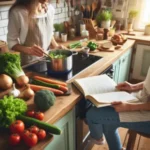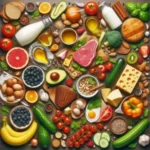In a world where culinary trends come and go, there’s something liberating about stepping into the kitchen without a recipe in hand.
Mastering the art of cooking without a recipe not only unleashes your inner chef but also invites a sense of adventure and creativity that can transform everyday meals into extraordinary experiences. Imagine the thrill of combining flavors, experimenting with textures, and embracing seasonal ingredients, all guided by your instincts rather than a rigid set of instructions. Whether you’re a seasoned cook looking to break free from the confines of structured recipes or a novice eager to explore the joys of improvisation, this blog post will equip you with essential tips and techniques to enhance your culinary creativity. From understanding flavor profiles and mastering basic techniques to learning how to trust your palate, we’ll dive into the exhilarating world of freestyle cooking, where the kitchen becomes your canvas and every meal is a masterpiece waiting to be created. Join us as we embark on a delicious journey that celebrates the art of cooking without boundaries!
1. Understanding the Basics of Flavors and Ingredients
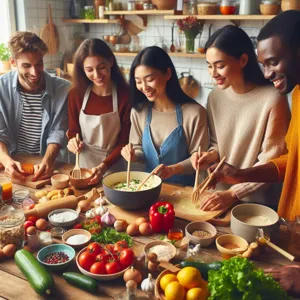
Understanding the basics of flavors and ingredients is the foundation upon which your culinary creativity will flourish. Before you can confidently toss aside the recipe and embark on your freestyle cooking adventure, it’s essential to familiarize yourself with the essential building blocks of flavor profiles and how they interact.
Start by exploring the five primary taste sensations: sweet, sour, salty, bitter, and umami. Each of these plays a vital role in creating a well-rounded dish. Sweetness can balance acidity, while a touch of salt can enhance the natural flavors of your ingredients. Understanding how these tastes work together allows you to elevate even the simplest of dishes into something extraordinary.
Next, dive into the world of ingredients. Familiarize yourself with herbs, spices, and other flavor enhancers. Fresh herbs like basil, cilantro, and parsley can add brightness and freshness, while spices such as cumin, paprika, and chili powder can introduce depth and warmth. Knowing which ingredients complement each other will empower you to mix and match freely, creating a harmonious symphony of flavors.
Consider also the various cooking techniques that can alter the flavor and texture of your ingredients. Sautéing brings out the sweetness in onions, while roasting can intensify the earthiness of root vegetables. Grilling adds a smoky char that can transform the simplest cuts of meat into a mouthwatering dish. By mastering these techniques, you’ll gain the confidence to improvise and make spontaneous decisions in the kitchen, guided by the ingredients you have on hand.
Finally, don’t shy away from experimentation. Taste as you go, adjusting seasoning and flavor combinations until they feel just right. Keep a journal of your culinary experiments—what worked, what didn’t, and what you’d like to try next time. This practice not only hones your palate but also sparks inspiration for future creations.
By building a solid understanding of flavors and ingredients, you’ll unlock the door to a world of culinary creativity. With these fundamentals in your toolkit, you’ll be well-equipped to cook freestyle, crafting delightful dishes that reflect your unique style and passion for food.
2. The Importance of Seasoning: Salt, Acid, Fat, and Heat
When it comes to cooking freestyle, mastering the balance of salt, acid, fat, and heat is essential. These four elements serve as the backbone of flavor development, transforming simple ingredients into extraordinary dishes. Understanding how to manipulate these components will empower you to create mouthwatering meals without the confines of a recipe.
**Salt** is often referred to as the magical enhancer of flavor. It doesn’t just make food taste salty; it elevates the inherent flavors of your ingredients. When you sprinkle salt on vegetables, meats, or even grains, you unlock their natural sweetness and depth. The key is to season as you go—adding a pinch here and a dash there—allowing the flavors to meld and develop throughout the cooking process.
**Acid** is another critical player in the flavor game. It brings brightness and freshness to your dishes, cutting through richness and balancing flavors. Think of a splash of lemon juice over roasted vegetables or a drizzle of balsamic vinegar on a hearty salad. Acid can awaken your palate, making each bite more vibrant and exciting. Experiment with different acidic ingredients, such as citrus, vinegars, or even yogurt, to find the perfect balance for your creations.
**Fat** plays a dual role in cooking—it not only carries flavor but also adds a luxurious mouthfeel to your dishes. Whether it’s the richness of olive oil, the creaminess of butter, or the depth of toasted nuts, fat rounds out the flavors and adds a satisfying texture. When cooking freestyle, don’t shy away from incorporating various fats; they can be used for sautéing, drizzling, or even as a finishing touch to elevate your dish.
Finally, **heat** is the element that brings everything together. The way you apply heat—whether through roasting, grilling, sautéing, or braising—will affect the final flavor and texture of your meal. High heat can create a beautiful caramelization, while lower temperatures may allow for gentler cooking, preserving the integrity of delicate ingredients. Understanding how and when to adjust the heat will help you achieve the desired results, enhancing the overall experience of your culinary creations.
By paying attention to the interplay of salt, acid, fat, and heat, you’ll develop an intuitive sense for flavor. This knowledge frees you from the constraints of recipes, allowing you to explore, experiment, and express your culinary creativity with confidence. Embrace the art of improvisation in the kitchen, and watch as you transform everyday ingredients into unforgettable meals.
3. Building a Well-Stocked Pantry for Freestyle Cooking
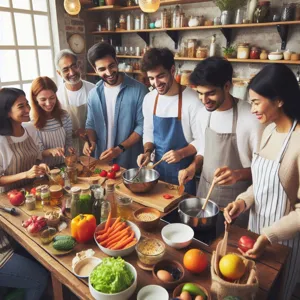
A well-stocked pantry is the cornerstone of successful freestyle cooking, serving as your creative playground where flavors, textures, and colors intertwine. Imagine opening your pantry doors to a treasure trove of ingredients, each waiting to inspire your next culinary masterpiece. The key to building a pantry that fuels your creativity lies in selecting versatile staples that can be combined in countless ways.
Start with the basics: grains and legumes. Quinoa, brown rice, and lentils are excellent foundations for a variety of dishes, providing both nutrition and substance. Pair these with a selection of canned tomatoes and broths, which can add depth and richness to your creations. Don’t forget about the power of spices and herbs; a well-curated spice rack can transform a simple dish into a flavorful experience. Stock up on essentials like cumin, paprika, oregano, and fresh herbs like basil and cilantro to elevate your meals with aromatic flair.
Include a variety of oils and vinegars in your pantry, as these can significantly enhance the flavor of your dishes. Olive oil, sesame oil, and a selection of vinegars—such as balsamic, red wine, and apple cider—offer a range of tastes that can complement any ingredient you choose. Additionally, consider keeping a few condiments on hand, like soy sauce, mustard, and hot sauce, to add that extra punch when needed.
Fresh produce is equally important in your freestyle cooking journey. While these items are not pantry staples, keeping a rotating selection of seasonal fruits and vegetables on hand can inspire spontaneity. Think of vibrant bell peppers, hearty root vegetables, and sweet seasonal fruits that can be incorporated into both savory and sweet dishes.
Finally, don’t forget about proteins. Whether it’s chicken, tofu, or legumes, having a few go-to options can help anchor your meals. With these building blocks in place, you’ll be ready to let your creativity flow, mixing and matching ingredients to create delicious and unique dishes without ever needing a recipe. A well-stocked pantry is not just a collection of items; it’s an invitation to experiment, innovate, and discover the joy of cooking freestyle.
4. Learning to Improvise with What You Have
Learning to improvise with what you have is at the heart of culinary creativity and the ultimate expression of freestyle cooking. Instead of being tethered to a rigid recipe, embrace the freedom that comes from using your pantry and refrigerator as your primary inspiration. Start by surveying your ingredients—what vegetables are on the verge of wilting? Do you have an abundance of herbs that need to be used? Perhaps a lone protein or a half-opened can of beans is waiting for its moment to shine.
Once you have a mental inventory of your supplies, let your imagination take the lead. Think about flavor profiles that might work well together. For instance, if you have fresh tomatoes, basil, and mozzarella, you might be inspired to create a vibrant salad or a quick pasta dish. If you’ve got a random assortment of grains, some leftover roasted vegetables, and nuts, toss them together with a simple vinaigrette for a hearty grain bowl.
Don’t be afraid to experiment! Cooking freestyle means taking risks and learning from your experiences. If you accidentally over-season a dish, you can balance it out with a touch of acidity or sweetness. If a combination doesn’t work out as planned, take note of what didn’t mesh and try something different next time.
Use improvisation as a way to express yourself and your tastes. If you love spicy food, add a kick with chili flakes or sriracha. If you prefer creamy textures, think about how you might incorporate yogurt, coconut milk, or cheese into your dish. Remember, cooking is an art form, and each meal you create is a canvas that reflects your unique personality and preferences.
So next time you step into your kitchen, forget the recipes for a moment and embrace the challenge of creating something new with what you have on hand. The joy of freestyle cooking lies not just in the final dish but in the process of discovery and the delicious surprises that await you.
5. Techniques for Flavor Pairing and Combining Ingredients
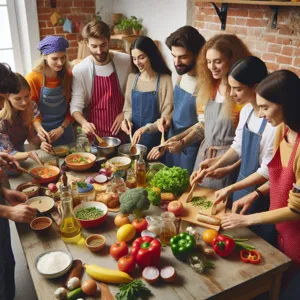
When it comes to cooking freestyle, mastering the techniques for flavor pairing and combining ingredients can elevate your culinary creations to new heights. The essence of this art lies in understanding how different flavors interact and enhance each other, allowing you to experiment boldly and confidently in the kitchen.
First, familiarize yourself with the flavor wheel, which categorizes tastes into groups like sweet, sour, salty, bitter, and umami. This foundational knowledge can guide you in creating harmonious combinations. For example, if you’re working with something sweet, like roasted butternut squash, consider pairing it with a touch of acidity, such as a drizzle of balsamic vinegar or a squeeze of fresh lemon juice. This contrast not only adds depth but also balances the dish beautifully.
Next, think about texture as a complementary factor in your dishes. Combining creamy elements, like a rich avocado or thick yogurt, with crunchy ingredients, such as toasted nuts or fresh vegetables, creates a delightful sensory experience. Experimenting with various textures can make even the simplest ingredients feel gourmet.
Don’t shy away from herbs and spices, either! Fresh herbs like basil, cilantro, and mint can transform a dish with their vibrant flavors. Meanwhile, spices such as cumin, paprika, or cardamom can add warmth and complexity. A dash of spice can awaken a dish in unexpected ways, so don’t hesitate to sprinkle, taste, and adjust as you go.
Finally, consider the seasonality of ingredients. Fresh, in-season produce not only tastes better but also pairs well together. A summer salad bursting with ripe tomatoes and cucumbers can be brightened with fresh basil and a splash of olive oil, while a cozy winter stew can thrive on root vegetables and hearty spices.
By embracing these techniques, you’ll cultivate an intuitive understanding of flavor dynamics, allowing you to create dishes that are not only unique but also irresistibly delicious. So grab those ingredients, trust your instincts, and let your creativity flow!
6. The Role of Textures in Creating Balanced Dishes
When it comes to mastering the art of cooking freestyle, understanding the role of textures in creating balanced dishes is paramount. Texture is what elevates a meal from ordinary to extraordinary, transforming a simple plate into a delightful sensory experience. Imagine the satisfying crunch of roasted vegetables juxtaposed against the creamy richness of a velvety sauce, or the tender bite of perfectly cooked pasta paired with the crisp snap of fresh herbs. These contrasting textures not only make a dish more visually appealing but also create a symphony of sensations that engage your palate.
As you embark on your culinary journey without the confines of a recipe, consider the textures available in your pantry and fridge. Embrace the variety—from the silky smoothness of pureed soups to the satisfying crunch of toasted nuts or crispy breadcrumbs. Incorporating a range of textures can enhance the overall experience of your dish and keep your taste buds excited.
For instance, when preparing a salad, think beyond just leafy greens. Add roasted chickpeas for a hearty crunch, creamy avocado for richness, and perhaps a sprinkle of feta for a crumbly, tangy bite. In a stir-fry, balance the crispness of fresh vegetables like bell peppers and snow peas with the tenderness of stir-fried tofu or seared meat. This interplay not only adds depth to your dish but also encourages a more engaging eating experience.
Experimentation is key. Don’t shy away from mixing different textures in unexpected ways. A smooth purée can serve as a base for crunchy toppings, while soft, braised meats can be paired with crisp pickled vegetables for contrast. By consciously considering the textures in your dishes, you will create harmonious balances that tantalize not just the taste buds but the entire dining experience.
Incorporating a variety of textures not only makes for visually stunning plates but also enhances the flavor profiles of your meals. So, the next time you step into the kitchen to cook freestyle, remember to think beyond flavors alone—explore the delightful world of textures, and watch as your culinary creations come to life in ways you never imagined.
7. Mastering Cooking Techniques: Sautéing, Roasting, Grilling, and More

Mastering cooking techniques is the cornerstone of culinary creativity. When you have a solid grasp of various methods—like sautéing, roasting, grilling, and braising—you arm yourself with the tools to transform simple ingredients into extraordinary dishes without relying on strict recipes. Each technique offers unique benefits and flavors, allowing you to experiment with a wide range of foods.
**Sautéing** is a quick and efficient way to bring out the natural flavors of your ingredients. Using a hot pan and a small amount of oil, you can achieve that perfect caramelization on vegetables, proteins, or aromatics like garlic and onions. The high heat helps lock in moisture while creating a beautiful golden-brown crust. Experiment by combining different ingredients, adjusting cooking times, and playing with spices to develop your signature sautéed creations.
**Roasting**, on the other hand, is a method that celebrates the beauty of slow cooking. Whether it’s root vegetables, meats, or even fruits, roasting enhances the natural sweetness and depth of flavor. The dry heat of the oven creates a crispy exterior while keeping the interior tender and juicy. Don’t be afraid to mix and match vegetables on the same tray, drizzling them with olive oil, herbs, and spices to discover delightful flavor combinations that reflect your palate.
**Grilling** introduces a smoky essence that is hard to replicate in other cooking methods. Whether you’re using a gas grill, charcoal, or even a stovetop grill pan, grilling allows you to infuse your food with rich flavors while creating beautiful grill marks. Try marinating proteins or tossing vegetables with olive oil and seasoning before grilling; the high heat will enhance their natural flavors while adding that coveted charred finish.
Finally, techniques like **braising** and **steaming** open the door to new textures and tastes. Braising combines both dry and moist heat, perfect for tougher cuts of meat or hearty vegetables, resulting in tender, flavor-infused dishes. Steaming is a healthier option that preserves nutrients and allows for the pure taste of ingredients to shine through—ideal for delicate foods like fish or greens.
As you learn and practice these techniques, remember that the key to cooking freestyle lies in your intuition. Taste as you go, adjust seasoning, and let your creativity flow. With each dish you prepare, you’ll grow more confident in your ability to transform whatever ingredients you have on hand into culinary masterpieces, all while savoring the joy of cooking without the confines of a recipe. Happy cooking!
8. Using Herbs and Spices to Elevate Your Dishes
Herbs and spices are the secret powerhouses in any kitchen, capable of transforming a mundane dish into a culinary masterpiece. When cooking freestyle, harnessing the vibrant flavors and aromatic profiles of these ingredients can elevate your meals and spark your creativity.
Start by exploring the vast world of fresh herbs—basil, cilantro, thyme, and rosemary are just a few that can add depth and brightness to your dishes. Fresh herbs should be added towards the end of cooking to preserve their vibrant flavors and beautiful colors. For instance, a sprinkle of fresh parsley or chives can brighten up a hearty stew or a creamy pasta, giving it a burst of freshness that tantalizes the palate.
On the other hand, dried spices are like little treasure chests of flavor waiting to be uncovered. They can be added at different stages of cooking to create layers of taste. Spices like cumin, smoked paprika, and coriander can impart warmth and complexity, while chili flakes can introduce a delightful kick. Don’t be afraid to experiment with spice blends, such as garam masala or za’atar, to transport your dishes to new culinary realms.
To truly master the art of cooking freestyle, consider the balance of flavors. Pairing sweet, savory, and spicy elements can turn a simple dish into a flavor symphony. For instance, a dash of cinnamon in a savory stew can create a warm and inviting profile, while a squeeze of lemon can brighten up the richness of a creamy sauce.
Remember, the key to using herbs and spices effectively is to trust your palate. Start with small amounts, taste as you go, and adjust according to your preference. This intuitive approach will not only enhance your cooking skills but also build your confidence in the kitchen. With herbs and spices as your allies, every dish can become a canvas for your culinary creativity, inviting you to explore and express your unique flavor profile.
9. The Art of Plating: Making Your Creations Visually Appealing
In the world of freestyle cooking, the journey doesn’t end when your dish is cooked; it reaches a new dimension when it’s time to plate. The art of plating is about transforming your culinary creations into visually stunning presentations that entice the eye and elevate the dining experience. Think of your plate as a blank canvas, where colors, textures, and shapes collide to tell a story.
First, consider the color palette of your dish. Aim for a balance that incorporates vibrant hues—such as the deep green of fresh herbs, the bright orange of roasted carrots, or the rich purples of beets—against a neutral backdrop, like a white or slate plate. This contrast not only makes the food pop but also draws attention to the ingredients themselves. Don’t shy away from garnishing; a sprinkle of microgreens, a drizzle of balsamic reduction, or a dollop of vibrant salsa can transform a simple dish into an eye-catching masterpiece.
Next, think about the arrangement of your components. Use the rule of thirds, a principle borrowed from photography, to create a balanced composition. Place your main protein in one-third of the plate, while the accompanying sides can be artfully arranged in the other two-thirds. This asymmetry adds intrigue and invites curiosity. Also, consider height—stacking elements vertically can create drama and make your dish more dynamic.
Textures play a crucial role as well. A crispy element, like fried shallots or toasted nuts, can contrast beautifully with creamy or soft components, such as a velvety puree or a delicate sauce. Layering these textures not only enhances the taste but also contributes to a visually stimulating experience.
Finally, don’t forget about the finishing touches. A light drizzle of high-quality olive oil, a sprinkle of flaky sea salt, or a few freshly cracked peppercorns can add that final flourish that elevates your dish from ordinary to extraordinary. Remember, plating is an expression of your culinary creativity—embrace the process, experiment with different styles, and most importantly, have fun as you transform your freestyle creations into artfully presented plates that will leave your diners in awe.
10. Overcoming Fear of Improvisation in the Kitchen
Overcoming the fear of improvisation in the kitchen is one of the most liberating steps you can take on your culinary journey. Many home cooks find themselves tethered to recipes, believing that the secret to a great dish lies solely in the precision of measurements and the exactness of ingredients. However, embracing the art of freestyle cooking opens up a world of creativity and personal expression.
Begin by shifting your mindset: view the kitchen as a canvas rather than a laboratory. It’s natural to feel apprehensive about straying from established guidelines, especially if you’ve spent years honing your skills with traditional recipes. Yet, every great chef started with uncertainty. Acknowledge that mistakes are part of the learning process, and often lead to unexpected discoveries.
Start small by choosing a few staple ingredients you enjoy. Allow your senses to guide you—consider the aroma, texture, and color of the ingredients at hand. Experiment with combinations that may not seem conventional: a sprinkle of cinnamon in your savory dishes or a dash of soy sauce in a fruit-based sauce can result in delightful surprises.
Moreover, don’t underestimate the power of seasoning. Herbs, spices, and acids (like lemon juice or vinegar) can transform even the simplest of dishes. Trust your palate. If something feels off, adjust it as you go. Remember, cooking is a dialogue between you and your ingredients; respond to the flavors as they unfold.
To build confidence, consider hosting a cooking night with friends. Encourage each other to create something unique without the constraints of a recipe. This supportive environment can help dispel fears and inspire daring creativity.
As you practice, you’ll find your culinary instincts sharpen. You’ll begin to recognize the balance of flavors, the harmony of textures, and the potential of unexpected ingredients. The kitchen will become your playground, where the fear of improvisation fades away, replaced by the thrill of discovery and the joy of creating dishes that are uniquely yours. Embrace the chaos, and let your creativity flow!
11. Experimenting with Global Cuisines and Ingredients
One of the most exhilarating aspects of cooking freestyle is the opportunity to explore global cuisines and ingredients, allowing your culinary creativity to flourish without the constraints of a recipe. This journey can transform your kitchen into a melting pot of flavors, aromas, and textures from around the world.
Start by stocking your pantry with a diverse array of spices, oils, and sauces that are hallmarks of various cuisines. Think fragrant cumin and coriander from Middle Eastern cooking, zesty harissa from North Africa, or bright, fresh herbs like cilantro and basil that are staples in Asian dishes. Each ingredient brings its own unique character, inviting you to play with traditional flavor profiles and create something entirely your own.
Don’t hesitate to visit local international markets or specialty stores to discover fresh, exotic ingredients that may be new to you. Consider the vibrant produce of Latin american cuisine, such as tomatillos and plantains, or the umami-rich mushrooms and greens found in Japanese cooking. Engaging with these ingredients can inspire you to combine culinary techniques and flavors that you might never have thought to pair.
As you experiment, remember that cooking is a sensory experience. Taste and smell are your best guides. If you’re trying a new spice, add a little, then a little more, and see how it transforms your dish. Don’t be afraid to mix and match—combine a Thai curry paste with Italian pasta, or use Indian spices to season a classic roast chicken.
Embrace the unexpected; sometimes the best dishes emerge from the most unlikely combinations. Invite friends or family to join you in this culinary adventure; cooking together can spark ideas and new approaches, turning each meal into a collaborative masterpiece.
As you immerse yourself in the world of global cuisines, you’ll not only enhance your cooking skills but also deepen your appreciation for the diverse tapestry of flavors that define our culinary heritage. With each experiment, you’ll build confidence in your intuition, learn to trust your palate, and ultimately master the art of cooking freestyle. Happy cooking!
12. Keeping a Culinary Journal: Documenting Your Creations
Keeping a culinary journal is one of the most rewarding practices you can adopt on your journey to mastering freestyle cooking. This journal serves as a canvas for your culinary creativity, allowing you to document your creations, thoughts, and experiences in the kitchen. It’s not just a record of what you’ve cooked; it’s a reflection of your growth as a cook and a source of inspiration for future culinary adventures.
As you experiment with flavors, techniques, and ingredients, jot down notes about what worked, what didn’t, and what you might try next time. Did that unexpected pinch of cayenne elevate your dish to new heights? Did a dash of lemon juice brighten up a heavy sauce? Capture those little victories and missteps alike; they are all part of your personal culinary journey. You may find yourself recording not just the recipes you’ve created but also the emotions and memories associated with each dish—perhaps the laughter shared over a meal with friends or the quiet satisfaction of a solo dinner.
Incorporate sketches of plating ideas or notes on presentation styles that caught your eye. Use your culinary journal to explore and document seasonal ingredients as they come into play, capturing the essence of each harvest and how they inspire your cooking. This practice not only helps you to remember your favorite combinations and techniques but also fosters a deeper connection to the food you prepare.
Moreover, revisiting your journal can spark new ideas and inspire you to recreate or reinvent dishes you loved in the past. It becomes a treasure trove of knowledge that reflects your unique culinary voice over time. So, grab a notebook (or go digital, if that suits you better) and start documenting your creations. The more you write, the more you’ll discover about your tastes, preferences, and style, ultimately enhancing your confidence in the kitchen and empowering you to cook freestyle with flair.
13. How to Taste and Adjust as You Cook
Cooking freestyle is all about trusting your instincts and honing your palate. One of the most vital skills in this culinary adventure is the ability to taste and adjust as you go. This process transforms a good dish into a great one and empowers you to tailor flavors to your liking.
Start by taking small, deliberate tastes throughout the cooking process. This isn’t just about ensuring your dish is seasoned properly; it’s an opportunity to discover the interplay of flavors and textures. A bite of a simmering sauce can reveal whether it needs a pinch more salt, a splash of acidity, or a hint of sweetness. Remember, flavors can evolve as they cook, so don’t be afraid to revisit your dish at different stages.
When you taste, think critically about what you’re experiencing. Is the dish too salty? A squeeze of lemon juice can brighten it up and balance the flavors. Is it lacking depth? A dash of soy sauce or Worcestershire sauce can introduce umami and complexity. If it feels flat, consider adding fresh herbs or spices for a vibrant lift.
Moreover, don’t forget the importance of texture in your adjustments. A sprinkle of toasted nuts can add crunch, while a swirl of cream can create a luscious finish. Each of these elements contributes to the overall experience of the dish.
As you taste and adjust, keep a notebook handy to jot down your thoughts. Over time, you’ll start to recognize patterns in your flavor preferences and develop a repertoire of adjustments that resonate with your palate. This practice will not only enhance your cooking but also build your confidence, allowing you to embrace spontaneity in the kitchen like never before. Cooking freestyle becomes not just an act of creating a meal but an expressive art form that showcases your unique culinary voice.
14. Embracing Mistakes as Learning Opportunities
In the journey of mastering freestyle cooking, embracing mistakes as learning opportunities is not just a mindset; it’s a crucial part of your culinary evolution. Every seasoned chef knows that the path to culinary creativity is often paved with missteps, but rather than shying away from these blunders, you should welcome them with open arms.
Picture this: you’re confidently experimenting with a new dish, adding a pinch of this and a dash of that, when suddenly, you realize you’ve added way too much salt or an unexpected spice that alters the entire flavor profile. Instead of viewing this as a disaster, take a moment to assess what happened. Was the flavor too overpowering? Could you balance it with something sweet or acidic? These moments of trial and error are golden opportunities for growth. They teach you about flavor balance, ingredient compatibility, and the art of improvisation in the kitchen.
Reflecting on your mistakes can also spark new ideas. Perhaps that overly salty soup can be transformed into a savory sauce, or that burnt edge of a cake can lead you to experiment with different baking times or temperatures. By keeping a positive attitude towards your culinary misadventures, you cultivate an environment of experimentation and creativity.
Moreover, documenting your cooking experiences—both the triumphs and the flops—can serve as a valuable resource. Jot down what went wrong and what you learned from it, creating your own personal encyclopedia of cooking wisdom. Over time, you’ll find that these so-called “mistakes” are actually stepping stones, leading you to develop a more intuitive understanding of flavors and techniques.
So, the next time you find yourself in the kitchen and things don’t go as planned, embrace it! Dive into the unexpected, taste everything, and remember: in the world of freestyle cooking, there are no failures—only lessons waiting to be discovered.
15. Building Confidence: From Home Cook to Freestyle Chef
Transitioning from a home cook to a freestyle chef is all about cultivating confidence in your culinary instincts and embracing the creative process. It’s easy to feel intimidated by the precision of recipes, but true mastery in the kitchen comes from understanding flavors, techniques, and, most importantly, your own palate.
Start by experimenting with ingredients you love. Select a few of your favorite vegetables, proteins, and spices, and challenge yourself to create a dish without relying on a recipe. Don’t shy away from making mistakes; they are essential to learning and discovering new flavor combinations. Each time you step into the kitchen, view it as an opportunity to play and explore rather than a task to check off your to-do list.
One effective way to build confidence is to familiarize yourself with fundamental cooking techniques. Mastering basic knife skills, sautéing, and roasting can give you the foundation you need to improvise. Once you feel comfortable with these skills, challenge yourself to switch up the ingredients in a dish you’ve mastered, allowing you to see how different flavors interact and complement one another.
Another key element is tasting as you go. This practice not only helps refine your palate but also encourages you to trust your instincts. Don’t be afraid to adjust seasonings or add a splash of acidity or sweetness; this is where the magic happens. With each dish you create, reflect on what worked and what didn’t, and use that insight to inform your next culinary adventure.
Finally, embrace the idea that cooking is a journey, not a destination. Celebrate your successes and learn from your failures, and soon you’ll find yourself confidently navigating your kitchen like a freestyle chef. With practice and passion, you’ll develop a unique style that is distinctly yours, turning every meal into an exciting expression of creativity.
As we wrap up our exploration of mastering the art of cooking freestyle, we hope you feel inspired to unleash your culinary creativity without the confines of traditional recipes. Embracing the freedom to experiment with flavors, textures, and techniques can transform your kitchen into a playground of innovation, allowing you to create dishes that are uniquely yours. Remember, the key to successful freestyle cooking lies in understanding the basics, trusting your instincts, and having fun along the way. So, gather your ingredients, let your imagination run wild, and savor the joy of crafting delicious meals that reflect your personal flair. Happy cooking, and may every dish you create be a delightful adventure!


